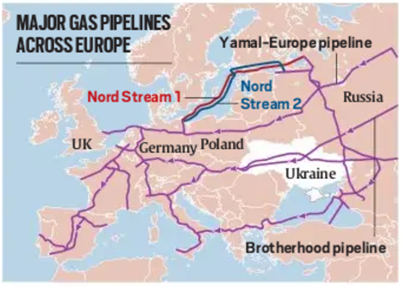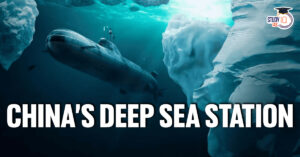Context: Ukraine has stopped the transit of Russian gas to Europe after a pre-war five-year transit deal expired.
About Russian Gas Transit Infrastructure
Before the war, Russia supplied nearly 40% of the EU’s pipeline natural gas, using 4 major routes:
- Nord Stream (Baltic Sea).
- Belarus-Poland pipeline.
- Ukraine pipeline network.
- TurkStream (Black Sea) to Turkey and Bulgaria.
Impact of the War
Gas flows via Nord Stream and Belarus-Poland pipelines were halted in 2022 due to disputes:
- Nord Stream pipeline: Damaged in a sabotage attack.
- Belarus-Poland pipeline: Stopped over Russia’s demand for payment in roubles.
- Ukraine pipeline network: Stopped on January 1, 2025.
- TurkStream: Still operational, supplying Turkey and Bulgaria.

- Decline in Russia’s Gas Exports to Europe
- Russia’s gas supply to Europe has drastically reduced from 35% to 8% since the invasion of Ukraine in February 2022.
Europe’s Energy Diversification
- The European Union has compensated for the loss of Russian gas by increasing imports of liquefied natural gas (LNG) and diversifying to non-Russian pipeline suppliers.
- Countries like Norway, the United States and Qatar have expanded their market share, replacing Russia as key energy providers.
Strategic Importance
- Economic: Gas exports are a major revenue source for Russia.
- Geopolitical: Control over gas transit routes has been a significant tool of influence, particularly in Europe.
- Energy Security: Many European nations depend on Russian gas, making the infrastructure critical for their energy needs.
Challenges
- Geopolitical Tensions: Sanctions and conflicts, such as the Ukraine crisis, have affected transit routes and international relations.
- Diversification: Efforts by European nations to reduce dependence on Russian gas, including investments in LNG and renewable energy.
- Aging Infrastructure: Maintenance and modernization are ongoing challenges for older segments of the network.


 Topological Materials: The Future of Qua...
Topological Materials: The Future of Qua...
 China’s Deep Sea Station in South Chin...
China’s Deep Sea Station in South Chin...
 Project ICE-CRUNCH: India-Switzerland Co...
Project ICE-CRUNCH: India-Switzerland Co...





















